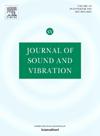Homogenization of the acoustic streaming in periodic rigid porous structures
IF 4.3
2区 工程技术
Q1 ACOUSTICS
引用次数: 0
Abstract
The paper presents a new model of the acoustic streaming (AS) in rigid porous media. The modelling is based on the classical perturbation approach combined with the periodic homogenization. The first one enables to linearize the Navier–Stokes equations for a barotropic fluid using the decomposition into the first and the second order subproblems governing the fluid dynamics in the rigid period scaffolds. The acoustic wave captured by the first order problem provides the Reynolds stress which appears in the second order problem as the streaming source term. Both the subproblems are treated by the homogenization resulting in the dynamic Darcy flow equations. Using spectral analysis of the characteristic microscopic dynamic Stokes flow and the associated spectral decomposition of the responses, the dynamic permeability is derived and also the driving force for the time-averaged permanent flow is evaluated. The AS can be observed at both the macroscopic and the microscopic levels. While the acoustics-driven microflows are observed for any microstructure, the macroscopic AS depends on the porous microstructure geometry, its nonsymmetry and boundary conditions. For porous particulate structures, the forces and force moments acting on the suspended particles are computed and the influence of the wave frequency and geometrical features is examined. All these effects are illustrated using 2D examples of periodic porous microstructures.
周期性刚性多孔结构中声流的均匀化
本文提出了一种新的刚性多孔介质声流模型。该模型基于经典摄动方法和周期均匀化方法。第一种方法是将正压流体的Navier-Stokes方程线性化,将其分解为控制刚性周期支架中流体动力学的一阶和二阶子问题。一阶问题捕获的声波提供了在二阶问题中作为流源项出现的雷诺应力。这两个子问题都用均匀化得到的动态达西流动方程来处理。利用特征微观动态斯托克斯流的谱分析和相应的响应谱分解,导出了动态渗透率,并对时间平均永久流的驱动力进行了评价。AS可以在宏观和微观两个层面上观察到。虽然在任何微观结构中都可以观察到声学驱动的微流,但宏观AS取决于多孔微观结构的几何形状、非对称性和边界条件。对于多孔颗粒结构,计算了作用在悬浮颗粒上的力和力矩,并考察了波浪频率和几何特征的影响。所有这些效应都是用二维周期性多孔微结构的例子来说明的。
本文章由计算机程序翻译,如有差异,请以英文原文为准。
求助全文
约1分钟内获得全文
求助全文
来源期刊

Journal of Sound and Vibration
工程技术-工程:机械
CiteScore
9.10
自引率
10.60%
发文量
551
审稿时长
69 days
期刊介绍:
The Journal of Sound and Vibration (JSV) is an independent journal devoted to the prompt publication of original papers, both theoretical and experimental, that provide new information on any aspect of sound or vibration. There is an emphasis on fundamental work that has potential for practical application.
JSV was founded and operates on the premise that the subject of sound and vibration requires a journal that publishes papers of a high technical standard across the various subdisciplines, thus facilitating awareness of techniques and discoveries in one area that may be applicable in others.
 求助内容:
求助内容: 应助结果提醒方式:
应助结果提醒方式:


